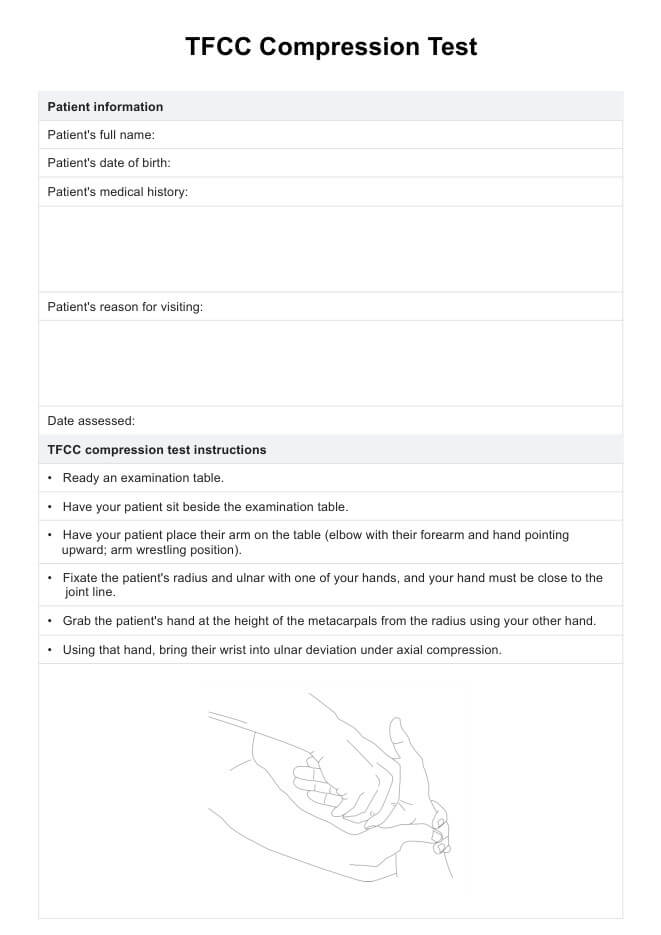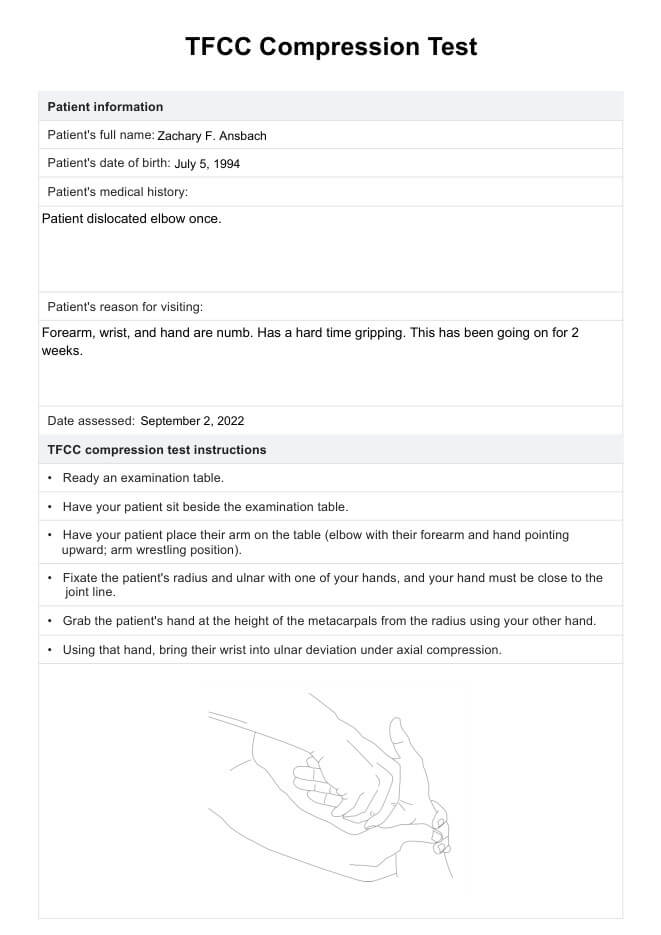TFCC Compression Test
Conduct the TFCC Compression Test to determine the possibility of your patient having a TFCC injury/lesion.


What is a triangular fibrocartilage complex lesion?
The triangular fibrocartilage complex (TFCC) comprises ligaments (such as the volar distal radioulnar ligaments) and cartilage. It ensures that the ulnar and radius bones (e.g., ulnar head) are attached to each other and the wrist bone. Plus, it also stabilizes and cushions the wrist.
If a triangular fibrocartilage complex (TFCC) is injured, healthcare professionals often refer to the injury as a TFCC tear or lesion.
Common symptoms of this lesion
Those with TFCC injuries will likely have the following symptoms:
- Ulnar-sided wrist pain
- Distal radioulnar joint instability
- Decreased range of motion in the wrist
- Difficulty with trying to grasp things
- Swelling in the wrist area
- Clicking sounds during wrist movement
Causes of this lesion
TFCC injuries may occur as a result of the following:
- Forced ulnar deviation
- Ulnar carpal impingement (or ulnar styloid impingement syndrome)
- Dorsal impingement
- Flexor muscle tendonitis
- Chronic degenerative injury
- Gout or arthritis
- Physical traumatic accidents (e.g., falling down, car crashes)
- Excessive and repetitive use of the wrists
- Simply aging
Do note that depending on the cause of the injury, the TFCC lesion will be given either a Type 1 or Type 2 designation.
Physical injuries or accidents cause type 1 TFCC lesions. On the other hand, Type 2 TFCC lesions emerge and worsen over time because of an underlying condition (e.g., gout or arthritis).
Those who are prone to getting TFCC injuries include athletes (especially those who partake in contact or combat sports), people with underlying conditions such as the ones mentioned earlier, and those who are age 50+.
TFCC Compression Test Template
TFCC Compression Test Sample
What is the TFCC Compression Test?
If a physical or occupational therapist is handling a patient who potentially has a TFCC injury, they will likely conduct the TFCC Compression Test, a common orthopedic physical examination maneuver that aims to assess the integrity of the TFCC and check for potential injuries.
How is this test conducted?
To conduct this test, let the patient sit beside the examination table. Have them place their arm on the table (elbow with their forearm and hand pointing upward; arm wrestling position). Then, fixate the patient's radius and ulnar with one of your hands, and your hand must be close to the joint line.
Afterward, use your other hand to grab the patient's hand at the height of the metacarpals from the radius. Using that hand, bring their wrist into ulnar deviation under axial compression (it's like you're bending it downward a bit).
How are the results interpreted?
The TFCC Compression Test looks for a specific sign: if the test reproduces the patient's pain and the wrist makes a clicking sound or crackles (crepitation).
If the patient feels pain while the examiner brings their wrist into ulnar deviation, and their wrist makes a clicking or crackling sound, the test is positive. It's negative if there's no pain.
If the test is positive, the examiner will endorse them for further examination, including other provocation tests, such as Fovea's Sign and Ulnar Grinding Test, and imaging tests, such as magnetic resonance imaging (MRI), to confirm the injury.
How to use our TFCC Compression Test template
Now that you understand the TFCC's function and how the complex can be injured, we'd like you to know that we created a template for the TFCC Compression Test. Normally, provocation tests don't come with test result recording sheets, so we created one!
Our template comes with the following:
- A patient medical history portion to indicate any past injuries that may have resulted in the TFCC injury over time
- A section to indicate why the patient is getting themselves checked for potential TFCC injuries (e.g., they suffered a fall with their arm fully extended, they were in a car accident)
- Instructions on how to perform the TFCC Compression Test, just in case the examiner needs to refresh
- Positive and negative options (with descriptions) to tick to indicate the test results
- A reminder to perform other provocation tests to establish consistency or narrow down the problem
- And a notes box for the examiner to indicate the next steps after conducting the TFCC Compression Test. They can even outline potential treatment plans here, if they wish.
Benefits
Using the TFCC Compression Test offers several benefits for practitioners. This includes the following:
The TFCC Compression Test is easy to conduct
The TFCC Compression Test is a simple provocation test. Other than an examination table for stabilizing the patient's arm, it doesn't require any important equipment. The instructions are easy, too, so conducting and accomplishing this test in a minute is possible.
Examiners don't even need to think about how to interpret the results because the test is looking for a specific sign. If that specific sign reveals itself as the test is conducted, it is positive.
It can be used as a monitoring test
Let's stipulate that the patient has been diagnosed with a TFCC injury/lesion. This test can be used to monitor them as they undergo treatment. By conducting this provocation test, examiners can observe if the pain is still or improving.
Treatments for TFCC lesions
The following treatments are often done upon identifying TFCC lesions or injuries:
Conservative treatment
Before resorting to anything drastic, it's best to try conservative treatment first. This includes having the patient rest and avoid using their affected wrist, using an ice compress and icing it for five to ten minutes every now and then, and taking over-the-counter painkillers.
Non-invasive treatment
If conservative treatment fails, it would be best to have them use a brace, cast, or splint to immobilize the wrist. If there's pain and over-the-counter painkillers aren't doing the trick, prescribe them certain pain medication to reduce pain and swelling. Having them undergo physical therapy after a while might also be best so they can regain strength in the affected wrist.
Wrist surgery
This should be the last resort. If everything else doesn't work, discuss surgery with the patient. If the patient consents to the risks, surgery can be performed on the patient. The most common surgery for this is arthroscopic debridement and TFCC repair.
Commonly asked questions
If TFCC lesions/injuries are left unchecked and unmanaged, the affected wrist may lead to persistent instability.
Distal radius fractures. There's a chance that patients with TFCC injuries have this type of fracture.
Corticosteroid injections can be part of a patient's treatment plan, but only if medicines like over-the-counter painkillers and NSAIDs don't work.
No. It's a provocation test. It's supposed to detect a patient's possibility of having a TFCC lesion. It's part of the diagnostic process, though. Imaging tests such as MRIs and arthroscopy should be able to confirm the problem after it's been narrowed down with other tests.







































































































